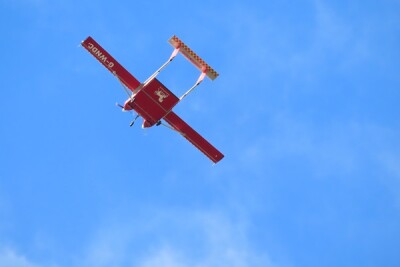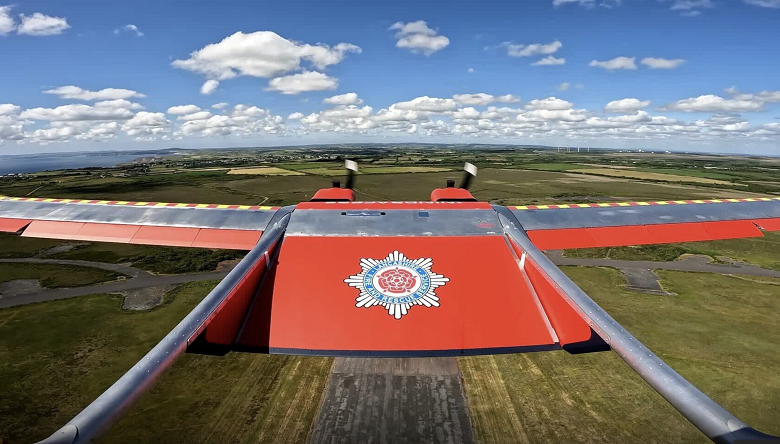Lancashire Fire Service, which spent 41 days battling a forest fire on 18 square kilometres of moorland near Bolton in 2018,  has tested a swarm of self-coordinating firefighting drones as part of its efforts to develop cost-effective strategies for early wildfire containment.
has tested a swarm of self-coordinating firefighting drones as part of its efforts to develop cost-effective strategies for early wildfire containment.
The project brought together Lancashire Fire and Rescue with Windracers, the UK manufacturer of self-flying cargo aircraft, and some of the country’s most respected AI and robotics scientists from the Universities of Bristol and Sheffield. Together they have developed a unique technology to autonomously detect and fight fires before they spread into uncontrollable wildfires.
“The sooner we arrive at fires, the less damage they cause to firefighters, communities, infrastructure and the environment,” says Justin Johnston, fire chief of Lancashire Fire and Rescue Service.
The Windracer ULTRA™ self-flying cargo aircraft, which have also been used to transport packages to the Orkney Islands and collect scientific data in Antarctica, can each carry 100kg of flame retardant. They can fly autonomously in a search pattern to monitor danger areas during the summer months, with a swarm of drones potentially covering areas the size of Greece.
Using the University of Sheffield’s AI technology – which includes thermal and optical imaging – the drones can automatically detect and investigate fires and relay all information to the fire service. Under the supervision of fire and rescue teams and using the University of Bristol’s swarm technology, the drones can then intelligently self-coordinate as first responders to quickly apply fire retardant to the fire, monitor the situation and return to base.
“This successful test was the culmination of four years of research and development, bringing together some of the country’s greatest minds in autonomous aviation, AI and robotics to tackle one of society’s greatest challenges,” commented Stephen Wright, Founder and Chief Executive Officer of Windracers. “We believe this extremely cost-effective technology could be a game-changer.”
 The week-long trial, which took place at Preddanack Airport in Cornwall, put the autonomous fire detection and swarming capabilities through their paces using an ULTRA and three smaller drones. ULTRA and the drones successfully identified and attacked a number of small, controlled fires – which were closely monitored by fire and rescue services. This is a major milestone in the development of wildfire prevention technology that, subject to regulatory approval, could be used by firefighters in the coming years.
The week-long trial, which took place at Preddanack Airport in Cornwall, put the autonomous fire detection and swarming capabilities through their paces using an ULTRA and three smaller drones. ULTRA and the drones successfully identified and attacked a number of small, controlled fires – which were closely monitored by fire and rescue services. This is a major milestone in the development of wildfire prevention technology that, subject to regulatory approval, could be used by firefighters in the coming years.
“The self-piloting swarm of flying drones could help firefighters detect a wildfire earlier, while also being able to pinpoint the exact location of the fire and summon other drones to help fight the fire before firefighters arrive on the scene. We are proud and delighted to be part of this trial, the first of its kind in the world, and to have a say in a technology that could significantly reduce the risk of wildfires,” adds Justin Johnston, Fire Chief of Lancashire Fire and Rescue Service.
The project was funded by UK Research and Innovation’s Future Flight competition and delivered by Innovate UK. ‘Protecting the environment through swarms of unmanned aerial vehicles’ was one of 17 projects sharing £73 million in funding to develop and demonstrate integrated aviation systems and new vehicle technologies.
“To detect and fight wildfires before they become a problem, many robots need to work together as a swarm,” explains Sabine Hauert, Professor of Swarm Engineering at the University of Bristol. “We talked to firefighters around the world to develop a swarm that would be useful and easy for them to use. It was great to see this technology tested for the first time.”
Wildfires have become more frequent, larger and more severe in the UK. Factors such as land use changes, higher temperatures, drought conditions and climate change are contributing to this trend. There were over 44,000 wildfires in 2022 – a 72% increase on the previous year.
About Windracers
Windracers started with a simple but bold idea: to find a cost-effective way to deliver emergency humanitarian aid over long distances where existing infrastructure is poor. In search of a solution, Windracers developed ULTRA™, a low-cost, reliable self-flying cargo aircraft controlled by Masterless™ avionics software. Windracers is on a mission to make low-cost self-flying cargo aircraft a reliable, everyday reality to bring prosperity to those who need it most. For more information, visit windracers.com
Source: Windracers

